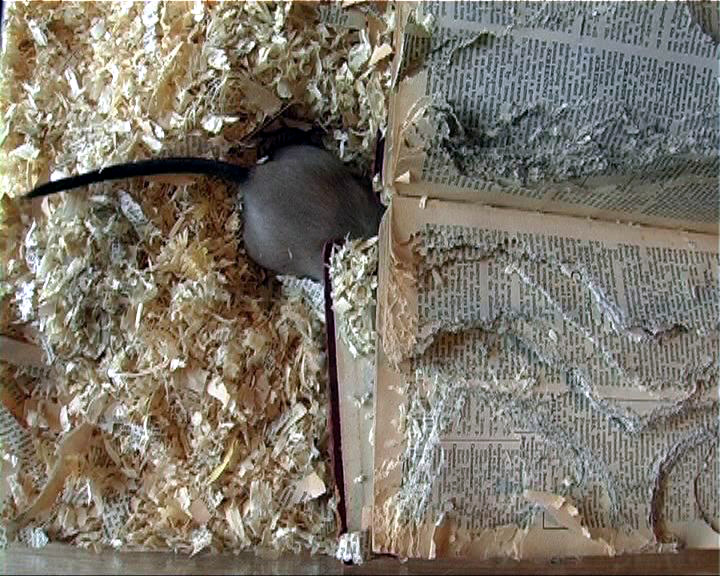In the gallery there is a live web feed of a gerbil in its cage chewing away at the pages of an old book. The book is a 1933 first edition of the New Illustrated Universal Reference Book. a compendium of carefully compiled, alphabetically organised facts where, to quote from the editor’s introduction, “the reader has a mine of information at his fingertips”.
Within theconfines of its restricted living space, this small rodent goes about the business of ‘mining’ the data for its own purposes. Over a period of several weeks the gerbil has ‘edited’ the book, translating the carefully constructed text into an unruly mass of dislocated fragments, recycling it as material for building a warm and secure nest. The fate of the book dissolves the architecture of knowledge into that of action. Likewise, the physical object diminishes in size as its shape mutates and disintegrates, and its architecture is demolished. Yet the gerbil as architect works to reconstruct its environment according to its own design.
Tom Jennings enjoys Sally Madge’s 2005 show; an art exhibition with real bite.
Rodent’s Eye View
Who thinks postmodern art is so much smug pretentious vacuous wank? Not always. Here, a pet gerbil enthusiastically munched its way through The New Illustrated Universal Reference Book - recycling via its physical labour the arrogant presumption that collections of information can encompass history and teach anything worth knowing. Who controls what goes in; what’s left out; how it’s presented and used? This rodent representative of the teeming masses followed its own universal agenda to keep warm, comfortable and secure - with no respect for the supposed wisdom and disciplining power dispensed by elites (1).
Unfortunately far too many exponents of contemporary artistic practice prefer to pose in the safety of their self-important cliques, venturing out only occasionally to lick the recuperative arses of art’s institutional markets. However, its unique capacity to condense, explore and encapsulate ideas and feelings means that art can critique the intersections of life, culture and politics in such a way as to intrigue and affect us - rather than bludgeoning us with the preachy self-satisfied ideological bullying that politicos are occasionally (!) guilty of. In this case the deployment of ironic reflexivity also illustrates an understanding that aesthetic manipulation (as in other kinds) always entails a rhetoric of power. So, as a ‘pet’, the gerbil has no ultimate control over the contours of its lifeworld. Instead these are provided by an apparently omnipotent superior agency claiming to be well-meaning but serving its own interest... Remind you of anything?
Footnoting the artist’s marvellous Underdog (2), this exemplary and humble bookwork straddles and references conceptual art and popular culture with more biting political pertinence than Douglas Adams’ middle class dressing-gowned slacker tourist (3) ever dreamt. Beautiful. Go gerbil!
Notes
1. The gerbil gets a second bite at the cherry throughout July when the exhibit resumes at the Waygood Gallery, High Bridge Street, Newcastle.
2. a 1999 video installation remake, with Sam Hooper soundtrack, of Luis Bunuel and Salvador Dali’s classic surrealist film Un Chien Andalou.
3. in The Hitchhiker’s Guide to the Galaxy.
Art review published in Freedom, Vol. 66, No. 14, July 2005
For other essays and reviews by Tom Jennings, see:
www.variant.org.uk
www.freedompress.org.uk
www.tomjennings.pwp.blueyonder.co.uk




